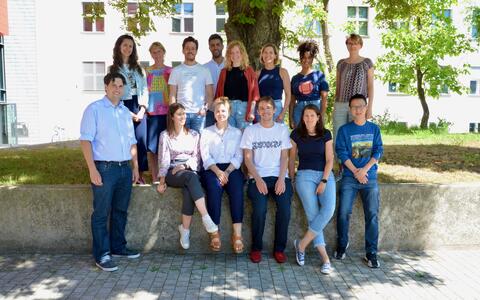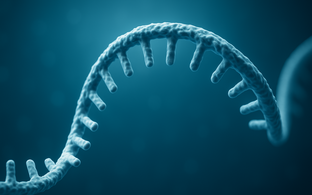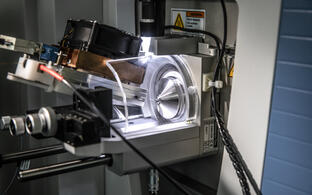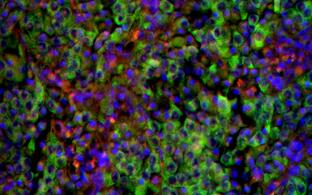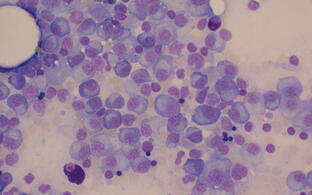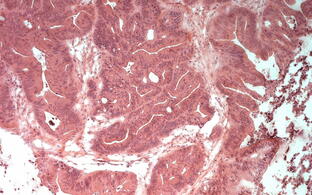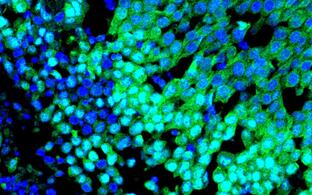Proteomics
Philipp Mertins
Profile
Proteomics enables the global and targeted analysis of all proteins and their functional states. Proteins are central to most biological functions within an organism and frequently alter in their abundance and in their activation status in disease. Thus, proteins are routinely used as disease biomarkers as well as drug targets.
To elucidate how proteins work, proteomics approaches make use of mass spectrometers. These high-throughput instruments allow proteins extracted from cells, tissues, and blood samples to be identified and quantified. In addition, it is possible to explore the binding partners of proteins, their localization in cells and tissues, and their functional activity.
Closing the performance gap
By augmenting throughput and coverage of proteomics approaches, we have contributed to closing the performance gap with regard to genomics techniques. Specifically, we have been able to demonstrate that proteomics analyses allow the reinforcement of findings from genomic sequencing studies (e.g. in cancer genomics), and enable researchers to gather additional information on precise disease mechanisms, such as how molecular signals and pathways are deregulated in a diseased state. A key task for the future will be to further increase the sensitivity of these techniques to make them applicable in routine clinical biopsy samples, possibly down to the single-cell level.
Our tools:
- Proteomics of cell lines, tissues and plasma samples
- Label-free, TMT- and iTRAQ-based global protein quantification
- Targeted protein quantification
- Post-translational modification analysis
- Ultrahigh-pressure liquid chromatography
- High-resolution orbitrap mass spectrometry
- Multi-omic and proteogenomic approaches
- Pathway and signaling bioinformatics
Further information can be found on the BIH Proteomics website.
Team
Group Leader
Secretariat
Staff Scientists
(BIH core unit)
(MDC core unit)
Computational Staff Scientist
(BIH core unit)
Technical Staff
(MDC)
(BIH core unit)
Mohamad Haji
(MDC core unit)
(MDC)
Engineers
(BIH core unit, jointly with Metabolomics Facility)
PostDocs
(MDC)
(DKFZ)
PhD and MD students
(MDC)
(MDC)
Alexandra Chitroceanu
(Charité )
(Charité)
(MDC)
(MDC)
(MDC)
(Charité)
Technology & Application
Understanding how proteins work
Our platform combines resources and services of MDC and BIH, develops mass spectrometry-driven proteomics methods and makes this technology available to partners at the Max Delbrück Center, Charité – Universitätsmedizin Berlin, and beyond.
The most common application in our group is the generation of global quantitative inventories of all proteins in cell or tissue samples, with the highest possible coverage and throughput for various biological or clinical states.
A special focus of our work is on improving multiplexing methods that enable us to analyze several samples at the same time, allowing us to either spend more time on an experiment and dig deeper into the proteome, or to analyze more samples at an even faster throughput.
We can also determine the activation status of the thousands of proteins we measure by detecting biochemical modifications, such as phosphorylation, ubiquitination, or acetylation groups in these proteins. Such modifiers act like molecular switches that turn functional states on and off.
Investigating proteins with sensitive and comprehensive methods (“deep coverage”) is crucial for connecting information about proteins with DNA-sequencing and RNA-sequencing information, since many genes that cause disease (and thus their protein products) occur at very low abundances. Reading out the consequences of genetic alterations on the protein level helps researchers to understand which mutations are possible drivers of disease and to identify potential drug targets.
For altered genes that have no known function in a certain context, it is also valuable to analyze the interaction partners of proteins. These may offer clues about specific roles in disease-causing processes. To validate initial discoveries, we employ targeted mass spectrometry methods that allow even higher throughput and could be used for biomarker analyses in future clinical studies.
Analysis methods
- Global proteome and post-translational modification (phosphorylation, ubiquitination, lysine-acetylation) profiling
- Customized proteome-wide quantification techniques, including label-free, SILAC, stable isotope dimethyl labeling, iTRAQ and TMT
- Targeted LC-MS/MS assays using SRM/PRM for highest accuracy and target verification
- Automated sample preparation using RTC-PAL robotics
- Data processing for primary peptide-, protein-, and PTM-site datasets in MaxQuant, Spectrum Mill and Skyline
- Data analysis in Perseus and R-packages with Shiny user interfaces
- Pathway- and signature-based analysis using single sample GSEA
- Feature identification and significance testing for differential, correlation, class-marker, enrichment, clustering, and outlier analysis
- Proteogenomic data integration by identification of sample-specific proteins with amino acid variants and cross-correlation analysis of CNA, RNA, and protein datasets
- Data quality control by routinely monitoring LC-MS/MS performance, quantification and interference analysis, annotation of MS2 spectra, and cross-correlation of multiple datasets







